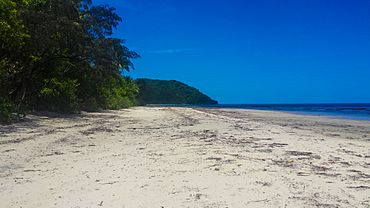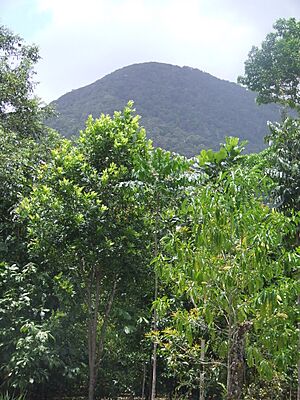Cape Tribulation, Queensland facts for kids
Quick facts for kids Cape TribulationQueensland |
|||||||||||||||
|---|---|---|---|---|---|---|---|---|---|---|---|---|---|---|---|

Cape Tribulation
|
|||||||||||||||
| Population | 123 (2021 census) | ||||||||||||||
| • Density | 0.979/km2 (2.54/sq mi) | ||||||||||||||
| Established | 1930s | ||||||||||||||
| Postcode(s) | 4873 | ||||||||||||||
| Area | 125.6 km2 (48.5 sq mi) | ||||||||||||||
| Time zone | AEST (UTC+10:00) | ||||||||||||||
| Location | |||||||||||||||
| LGA(s) | Shire of Douglas | ||||||||||||||
| State electorate(s) | Cook | ||||||||||||||
| Federal Division(s) | Leichhardt | ||||||||||||||
|
|||||||||||||||
Cape Tribulation is a special place in northern Queensland, Australia. It is a headland, which means a piece of land that sticks out into the sea. It is also a small community. In 2021, about 123 people lived there.
Contents
- Where is Cape Tribulation?
- Who lived in Cape Tribulation first?
- How did Cape Tribulation get its name?
- When did people settle here?
- What was the Bloomfield Track blockade?
- How many people live here?
- Are there schools in Cape Tribulation?
- What is the weather like?
- What can you see in Cape Tribulation?
Where is Cape Tribulation?
Cape Tribulation is about 110 kilometers (68 miles) north of Cairns. It is part of the amazing Daintree National Park. This area is also a World Heritage area called the Wet Tropics. This means it is a very important natural place that is protected by the world.
The main road, Cape Tribulation Bloomfield Road, goes through the area. You can find a few places to stay here, like eco-lodges and hostels. Some very rare plants grow in this unique rainforest.
Who lived in Cape Tribulation first?
The traditional owners of the land around Cape Tribulation are the Kuku Yalanji people. Their language is an Aboriginal language spoken in this part of Far North Queensland. Their traditional lands stretch from the Mossman River in the south to the Annan River in the north. This includes towns like Cooktown, Mossman, and Daintree.
How did Cape Tribulation get its name?
The name Cape Tribulation was given by a famous British navigator named Lieutenant James Cook. This happened on June 10, 1770. Cook's ship, the Endeavour, hit a reef north-east of the cape. The ship was badly damaged and almost sank!
Cook wrote in his logbook that he named the place Cape Tribulation because "here begun all our troubles." The ship eventually got free and was repaired.
When did people settle here?
In the 1930s, some European settlers started to arrive in Cape Tribulation. It was very hard to live here because of the thick rainforest. People tried different things like farming, fishing, and cutting timber. But it was difficult because the only way to get supplies was by weekly boats.
In the 1960s, a rough track was made, allowing vehicles to reach the area. For many years, it was only a four-wheel drive track. The road was finally paved all the way in 2002. In 2011, the last bridge was built, making it easier to visit Cape Tribulation all year round.
What was the Bloomfield Track blockade?
In 1983, Cape Tribulation became well-known because of a protest called the blockade on the Bloomfield Track. The local government wanted to build a road right through the rainforest. People who cared about the environment tried to stop the bulldozers. They even sat in trees to protect them!
Even with the protests, the road was finished quickly. But because of these events, the state and federal governments realized how special this ancient rainforest was. In 1988, the forests around Cape Tribulation were given World Heritage Listing. This means they are now protected for everyone to enjoy.
How many people live here?
In 2016, Cape Tribulation had 118 people living there. By 2021, the population had grown slightly to 123 people.
Are there schools in Cape Tribulation?
There are no schools directly in Cape Tribulation. Younger students might go to primary schools in nearby towns like Bloomfield or Diwan. For high school, students usually do distance education (learning from home) or go to a boarding school.
What is the weather like?
Cape Tribulation gets a lot of rain! The average rainfall each year is about 3,900 millimeters (about 153 inches). This is why the rainforest is so lush and green.
What can you see in Cape Tribulation?
There are several great places to visit and enjoy the views in Cape Tribulation:
- Mount Sorrow Ridge Trail Lookout
- Kulki Boardwalk Lookout
- Marrja Boardwalk Lookout



